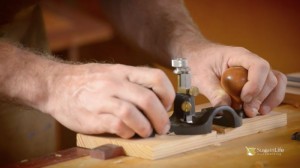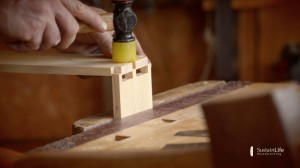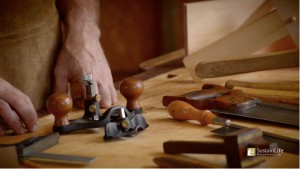Introduction
In the Basics of Joinery online course, you will learn the three basic joints–dado, dovetail and mortise and tenon–that are the foundation for all wood joinery. Learn these three well and you can build almost anything out of wood. The techniques Frank teaches in this course are the base for all the endless variations of woodworking joints.
Frank will start by showing how to use a handsaw, going from proper holding techniques and posture to several sawing practice exercises. He then lays out and cutting a dado joint. This joint is common for in bookshelves, dressers and more. Then, Frank demystifies the dovetail joint by showing you how to lay out and cut a single dovetail. (You will keep developing this skill in the next course, “Building a Dovetail Box”, by making a box with each corner joined by a double dovetail.) The last joint you will learn here is the mortise and tenon, used in doors, chairs, tables and more. Frank shows you how important careful layout is and then walks you step by step through cutting and fitting the joint. He also shows you a few ways to secure the mortise and tenon joint: the old draw bore pegged method and wedges. Finally, even though it’s not a joint, since the hand plane is such an important tool we’ve included a bonus track on the basics of hand plane use.
 Frank progresses methodically through each joint, building one on another with detailed instructions on proper technique for the many tools. After finishing this course, you’ll have a foundational grasp on the basic woodworking tools; chisels, saws, marking gauge, hand plane, marking knife and more. You’ll be confident laying out the basic joints as well as knowing where to use each joint in any project. The joint exercises you learn in this course are perfect to practice to prepare for the next courses where you’ll use the joints in an actual project.
Frank progresses methodically through each joint, building one on another with detailed instructions on proper technique for the many tools. After finishing this course, you’ll have a foundational grasp on the basic woodworking tools; chisels, saws, marking gauge, hand plane, marking knife and more. You’ll be confident laying out the basic joints as well as knowing where to use each joint in any project. The joint exercises you learn in this course are perfect to practice to prepare for the next courses where you’ll use the joints in an actual project.
Take the Joinery course now!
Prerequisites
We highly recommend you watch the course “Sharpening Hand Tools” before taking this course. The single most important factor for joinery success is a razor-sharp tool.
Tools you’ll need:
-
Dovetail Saw
- Combination Square
- Set of Chisels
- Mallet
- Assembly Hammer
- Sliding Bevel or Dovetail Marker
- Router plane
- Marking Gauge
- Marking Knife
- Tenon Saw
- Pencil
As Frank says:
In this series I’m going to show you how to cut each one of these joints as well as different techniques that are used in the process of using the tools in cutting the joints, techniques that I use in my everyday woodworking building furniture….Although they may be somewhat simple, I think you’ll find these exercises will be very rewarding to go through and also great practice before you actually start building a project, you can use these different exercises as a warm-up….
Teaser:
Take the Joinery course now!
See our on-campus joinery course here.


I attended the basics course several years ago. It covered sharpening of saws and chisels and the 3 basic joints. I came away somewhat frustrated because I came into the course with almost no wood working experience and every one else seemed to have some skills already developed. I did learn some things but I was unable to complete some of the practice joints. I think it would help if you would put out in DVD format some of your basics so I could get in a little practice at home before going back to Waco for another hands on course.
Hello James,
I am sorry to hear that you went away frustrated but I am happy to tell you that I believe we have a solution to the problem. We just recently launched a series of online courses starting with the basics. We have a whole in depth series on sharpening, then we have a whole other series on the three joints. This is exactly what you would have learned in the course and even more. The great thing about this is you can watch it in the comfort of your own home and take it at your own pace and even watch it as many times as you like. We have filmed and plan to launch the next series which will be making the box, shelf and small table.
Again all what you would learn if you took our Foundational course. As an added bonus all of the video content is available in text format so you can read through it if you would like. You can also ask questions, post pictures and even videos as you move through the course, if you have any problems as you are working through the material.
There is a monthly or yearly fee for the online courses but there are plenty of free videos that you can get an idea of what the material is about. You can also sign up for a free 2 day trial.
So I hope you go watch a few of these videos and let me know what you think.
You can find all the information right here.
http://www.sustainlife.org/catalog/online-courses/traditional-crafts-online-courses/woodworking-traditional-crafts-online-courses/
Thank you and please let me know if you have any other questions, I am here to help.
Frank